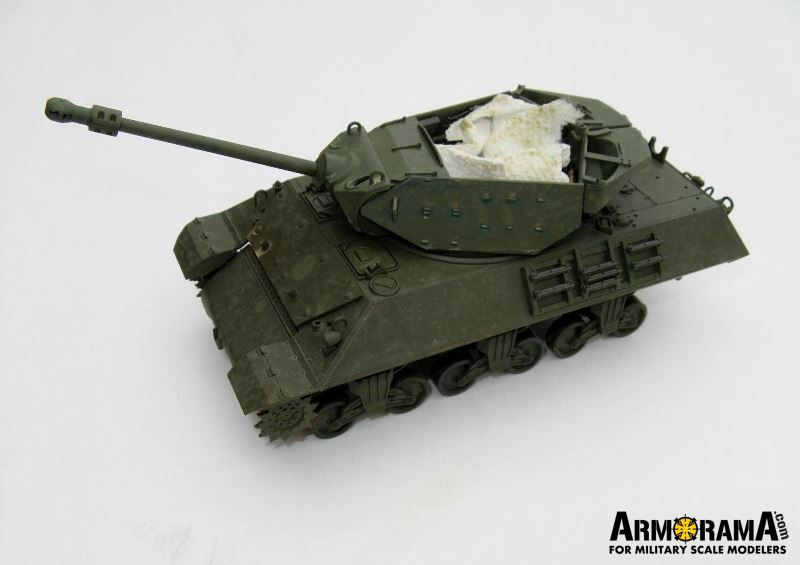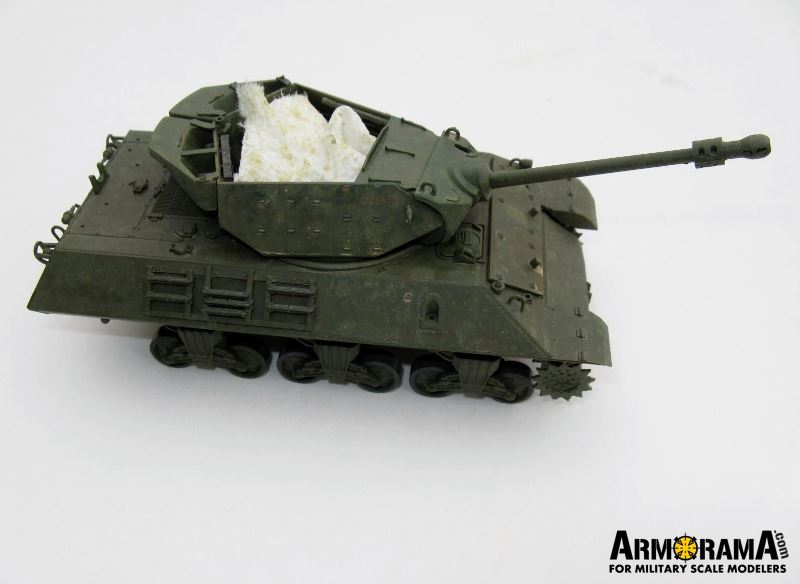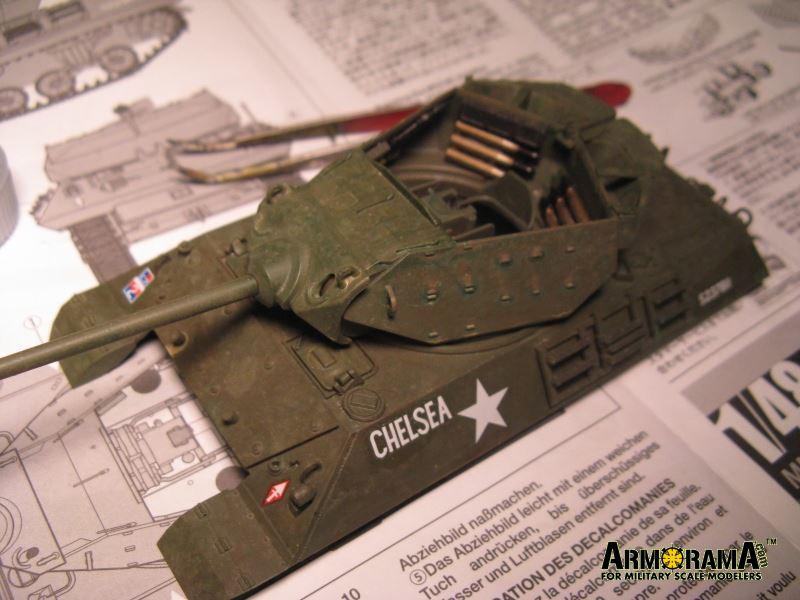Is there an inherent conflict between the oil dot method and doing enamel pin washes? Namely, doesn't the cleanup of one method also wipe clear the underlying method?
What's the right way to approach this if you want both effects?
Thanks!
AFV Painting & Weathering
Answers to questions about the right paint scheme or tips for the right effect.
Answers to questions about the right paint scheme or tips for the right effect.
Hosted by Darren Baker, Matthew Toms
Oil dot method + pin washes
Posted: Monday, February 23, 2015 - 04:30 AM UTC

Tojo72

Joined: June 06, 2006
KitMaker: 4,691 posts
Armorama: 3,509 posts

Posted: Monday, February 23, 2015 - 04:49 AM UTC
I would seal one effect with acrylic clear before doing the other.

Thudius

Joined: October 22, 2012
KitMaker: 1,194 posts
Armorama: 1,077 posts

Posted: Monday, February 23, 2015 - 04:50 AM UTC
Pin washes are very precise applications rather than a sludge or overall wash, hence the name. It's used to deliberately pick out details that you want enhanced, bolt heads, weld beads etc or staining that you didn't get with an overall wash. I'd say that the dot filter should be applied before the pin wash as you will get some messing about when blending and you will probably lose some of the intensity of the initial wash.
Kimmo
Kimmo

bison126

Joined: June 10, 2004
KitMaker: 5,329 posts
Armorama: 5,204 posts

Posted: Monday, February 23, 2015 - 01:29 PM UTC
I second Kimmo's opinion. Apply oil dots first then the pinwash.
Olivier
Olivier

BBD468

Joined: March 08, 2010
KitMaker: 2,465 posts
Armorama: 2,383 posts

Posted: Monday, February 23, 2015 - 08:11 PM UTC
Quoted Text
I would seal one effect with acrylic clear before doing the other.
Thats the key right there and how i do it as well.


Motives

Joined: October 15, 2013
KitMaker: 444 posts
Armorama: 428 posts

Posted: Monday, February 23, 2015 - 08:49 PM UTC
Quoted Text
Quoted TextI would seal one effect with acrylic clear before doing the other.
Thats the key right there and how i do it as well.
I suppose it depends on what effect one is after. I've found that blending the pin-wash into the filter/dot layer can produce good results and give a lot of depth.
Needless to say the pinwash needs to be added with some caution. If it gets too messy a lot of thinner is needed to clean it up and that will most definitely remove the dotfilter as well.

Motives

Joined: October 15, 2013
KitMaker: 444 posts
Armorama: 428 posts

Posted: Monday, February 23, 2015 - 09:06 PM UTC
I actually made this pic for a discussion in our local discussion group regarding how much one can alter values from the basecoat:
https://dl.dropboxusercontent.com/s/0no5zhlqwj63v2f/dotfilter123.jpg?dl=0
Note its a huge pic! Either way, this is not sealed between coats
https://dl.dropboxusercontent.com/s/0no5zhlqwj63v2f/dotfilter123.jpg?dl=0
Note its a huge pic! Either way, this is not sealed between coats
Posted: Monday, February 23, 2015 - 09:12 PM UTC
Johan, thanks for the image. Very interesting!
So this actually makes me want to ask another, broader question: what are the best how-to resources for the dot method? Anyone have any great ones or any tips? In looking at Johan's image, I'm not sure I'm doing it "right"
So this actually makes me want to ask another, broader question: what are the best how-to resources for the dot method? Anyone have any great ones or any tips? In looking at Johan's image, I'm not sure I'm doing it "right"

SdAufKla

Joined: May 07, 2010
KitMaker: 2,238 posts
Armorama: 2,158 posts

Posted: Tuesday, February 24, 2015 - 06:06 AM UTC
At the risk of sounding too cheesy, I'd say that Rinaldi's "Tank Art" books offer some of the best SBS descriptions for using oil paints for AFV finishes.
The "oil dot" method is something of a shotgun approach, and Rinaldi's descriptions of what he calls "Oil Paint Rendering" or "OPR" are of a much more refined application method.
He also doesn't seem to be tied to the promotion of any particular brand of paints or finish products, so IMO, that gives his books an extra bit of credibility that some other similar books lack. All too many of these finishing SBS books are really page after page of product promotion with techniques described that are specific product dependent.
Rinaldi doesn't fall into that trap, and he really focuses on the techniques and methods using whatever products he finds most useful. I find that pretty refreshing, actually.
Anyways, since you ask, that's my opinion.
The "oil dot" method is something of a shotgun approach, and Rinaldi's descriptions of what he calls "Oil Paint Rendering" or "OPR" are of a much more refined application method.
He also doesn't seem to be tied to the promotion of any particular brand of paints or finish products, so IMO, that gives his books an extra bit of credibility that some other similar books lack. All too many of these finishing SBS books are really page after page of product promotion with techniques described that are specific product dependent.
Rinaldi doesn't fall into that trap, and he really focuses on the techniques and methods using whatever products he finds most useful. I find that pretty refreshing, actually.
Anyways, since you ask, that's my opinion.

Motives

Joined: October 15, 2013
KitMaker: 444 posts
Armorama: 428 posts

Posted: Tuesday, February 24, 2015 - 11:46 AM UTC
Quoted Text
I'm not sure I'm doing it "right"
Well, I dont think I'm doing it right either

Here is a link to Rinaldi's "Oil Paint Rendering - an Introduction" from 2011:
http://www.missing-lynx.com/articles/other/oilpaintrenderingmr_1.html
I had a search on the forum and found this post were another quite excellent modeller shares his thoughts:
http://armorama.com/forums/214184

tha_militant

Joined: August 14, 2012
KitMaker: 36 posts
Armorama: 19 posts

Posted: Tuesday, February 24, 2015 - 12:55 PM UTC
Quoted Text
At the risk of sounding too cheesy, I'd say that Rinaldi's "Tank Art" books offer some of the best SBS descriptions for using oil paints for AFV finishes.
The "oil dot" method is something of a shotgun approach, and Rinaldi's descriptions of what he calls "Oil Paint Rendering" or "OPR" are of a much more refined application method.
He also doesn't seem to be tied to the promotion of any particular brand of paints or finish products, so IMO, that gives his books an extra bit of credibility that some other similar books lack. All too many of these finishing SBS books are really page after page of product promotion with techniques described that are specific product dependent.
Rinaldi doesn't fall into that trap, and he really focuses on the techniques and methods using whatever products he finds most useful. I find that pretty refreshing, actually.
Anyways, since you ask, that's my opinion.
he's big on the tres'semme hairspray lol totally agree though he's uses a multitude of products
I have all the books if I had to guess his tamiya paint stirrer and the abteilung odorless are some of the things he praises the most and cardboard for the artist oils the books are awesome worth every penny
Posted: Tuesday, February 24, 2015 - 01:18 PM UTC
Hi Jake,
The men have provided some excellent ideas and techniques. Here is a technique I use (as well as those you and they have cited - esp. Mike's [SdAufKla].)
It doesn't give quite the control yet that is what, in my eye, makes a pleasing chaotic variation in colors. I call it 'flick brushing' or 'spatter painting'.
This is a rusty hulk but it works with any colors: http://railroadmodeling.kitmaker.net/review/9409
Here's how it can look an AFV:



On another model:


I don't know if you like those as much as the effects of Oil dot method + pin washes. I combine them all as necessary to fulfill my vision.
The men have provided some excellent ideas and techniques. Here is a technique I use (as well as those you and they have cited - esp. Mike's [SdAufKla].)
It doesn't give quite the control yet that is what, in my eye, makes a pleasing chaotic variation in colors. I call it 'flick brushing' or 'spatter painting'.
This is a rusty hulk but it works with any colors: http://railroadmodeling.kitmaker.net/review/9409
Here's how it can look an AFV:



On another model:


I don't know if you like those as much as the effects of Oil dot method + pin washes. I combine them all as necessary to fulfill my vision.

spongya


Joined: February 01, 2005
KitMaker: 2,365 posts
Armorama: 1,709 posts

Posted: Tuesday, February 24, 2015 - 04:33 PM UTC
I don't think there's a conflict. In fact, pin washes can be done immediately after the last dot filter is applied, and the surface is still wet. When you do a pin wash, you ideally don't create excess that needs to be wiped off, so if you're precise enough, it should be OK. In fact, this is how I usually do it.
 |













